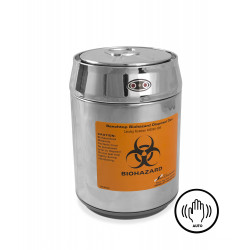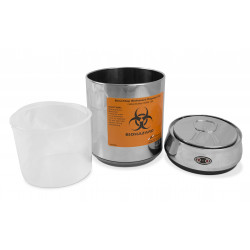
In the course of the experiment, the researchers will certainly encounter contact with the dangerous goods in the laboratory. In addition to paying attention to the use of dangerous goods in the operation process, the appropriate collection and treatment of laboratory hazardous waste after the use can not be ignored.
Laboratory hazardous waste refers to the waste and its pollutants that are harmful to the national human health or are included in the National Hazardous Waste List (2021 edition,China) and produced in the teaching and scientific research process of various laboratories or experimental sites.
Laboratory conventional hazardous waste is mainly divided into four categories: waste chemical reagent, bottled waste liquid, empty reagent bottle and contaminated waste.
General methods for laboratory waste collection
1.Classification collection method
Collect according to the nature and status of waste.
2. Collect according to the quantity
Collect according to the nature and status of waste.
3 Similar classification and collection method
Waste with similar properties or treatment methods and methods shall be collected together.
4 Separate collection method
Hazardous waste shall be collected and treated separately.
Question:
However, in the process of experimental operation, the traditional dustbin sometimes requires the operator to touch the open lid with his hands, which is not convenient and cannot guarantee the sterile operation of the subsequent experimental process. What should I do?
Answer:
The existence of a small covered biohazard treatment tank has well solved the temporary storage problem of waste on the experimental operating table.
Bel-Art Benchtop Biohazard Disposal Can with Motion Sensor Lid
High performance automation
Bel-Art Benchtop Biohazard Disposal Can with Motion Sensor Lid is well sized and smart for placement on the operating table. Closed closed desktop biohazard tanks are suitable for handling small items that may contain odors, such as pipette tips and microcentrifuge tubes. Open the lid automatically and use use; close automatically and provide more hygienic console environment.
Technical parameter
Bel-Art Benchtop Biohazard Disposal Can with Motion Sensor Lid based on infrared technology eliminates the risk of contamination during operation. Just place your hand approximately 10cm above the infrared panel, and the lid of the biohazard waste can will automatically open. Within seconds, it will automatically shut down again.
·A 1.5-liter capacity, stainless steel material
·25 x 25 cm (10 x 10 in) (F13166-0000 or H13182-1010)
·Includes a polypropylene liner with a handle to easily clear the contents
·Beautiful and durable; stainless steel body and chrome cover are resistant to bleaching and easy to clean
·Three AAA batteries (excluded) is required
·Compliance with CE and RoHS certification
Cleaning guide
1.Just wipe and clean with a wet cloth;
2. Use ethanol (70%) or bleach to clean the plastic lining and tank.



3 Comment(s)
1
1
1
1
1
1
1
1
Leave a Comment